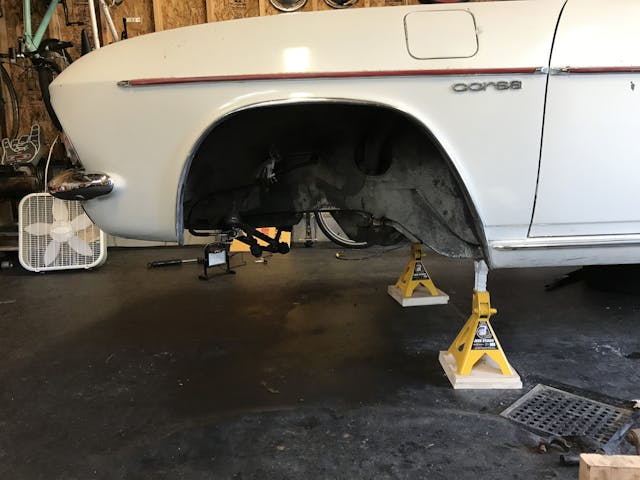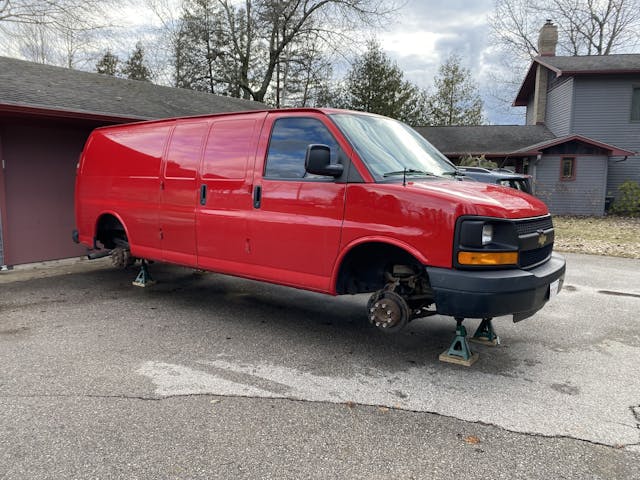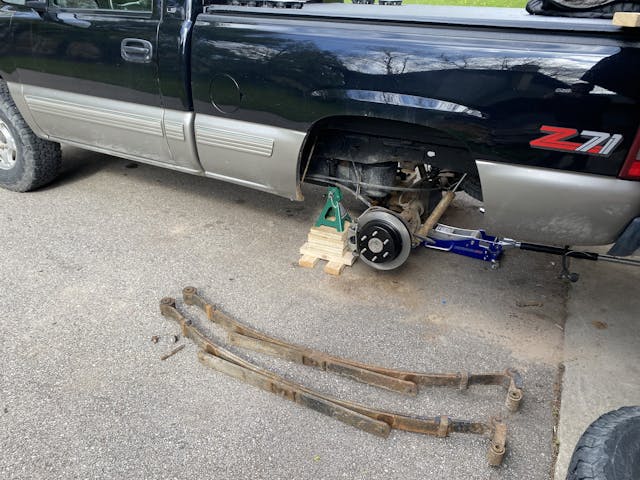6 tips for using jack stands
Working on cars requires a whole slew of relatively specialized tools. Often times we don’t even realize how unique those tools and practices are until we talk to someone new to the hobby. Or someone who is on the outside looking in. Just one example: How casually we discuss (and practice) the act of lifting our multi-thousand pound vehicles into the air and then supporting them with separate load-bearing apparatuses that allow us to work on, disassemble, or reach under the vehicles. It’s dangerous when done right, and deadly when done wrong.
That sounds scary, and to a point it should be. Being cautious when the risks are this high is not a bad thing. That’s why we created a quick list of tips for using jack stands: good for newbies, but it’s also a refresher for those experienced enough to have lifted up a vehicle many times, in many ways over the years.
Buy once, cry never

There are many factors in selecting jack stands, and price is one that many of us are forced to consider. While tools can and will be shopped based on price point, jack stands should not be one of them. These are critical safety items that should come from reputable and trustworthy sources. The Harbor Freight jack stand debacle of 2020 should be burned in our collective memory for a long time, as being crushed by your car is not the way to go. Cheaping out with jack stands is a fast track to a mere feeling of safety, rather than possessing actual safety.
Jack stands should be sturdy with a good wide base. A secondary method of locking them at the desired height is also a plus. Do not modify jack stands or otherwise compromise safety features in the name of convenience. Doing so is only making it easier to get hurt.
Size appropriately

Jack stands produced after 2015 are rated as a pair. Which means if you find some at the local parts store that say they are “three-ton” jack stands, the ability to support the claimed 6000 pounds requires both stands. In reality, three-ton jack stands should be the smallest used in most home shops, as it gives a good safety margin when working on smaller cars, yet a set of four does have enough capability to hold a medium-sized truck or SUV in a pinch.
Remember that storing jack stands can be a hassle, so having one set that covers anything you’ll work on is the best way to go. That said, a small and large set of them is a nice luxury if you have the space. Inevitably something gets “stranded” on your one set of stands…and you’ll need another set shortly thereafter.
Trace the load path

Jack stand placement is as critical (if not more critical!) than proper sizing. The biggest jack stand in the world is useless if you place it in the wrong spot, letting the car fall down anyway. The service manual is the best place to look for jack points and jack stand placements. Even the owner’s manual in the glove box, a book that’s been shrinking over time and loaded with “please see dealer” language, likely still outlines the jack points for safe lifting. A quick internet search will likely reveal appropriate information too.
But sometimes that doesn’t work, or what you are doing is something the original engineer from decades past could have never imagined. That’s when a little bit of critical thinking goes a long way. Look under the car and locate a place that looks sturdy enough to place a jack stand, then follow what that is connected to. From there, imagine how it would support the load being placed on it. Supporting the rear of a car by placing stands under the rear differential makes sense because the entire weight of the car is normally supported by that part. Using a bumper or frame brace that doesn’t support and wasn’t designed for that load is a bad place to put a stand. If unsure, consult professionals.
Do the shake test

Now that your project is up in the air and supported by jack stands, there is one last step before you roll underneath: You gotta shake it. No, not the latest TikTok dance. Shake the car. Go to one of the corners and give it a good push and pull to make sure the car is stable and the stands are not going to move or shift while you are underneath. This is the same thing that mechanics in shops do when putting a car on a two post lift.
After all, now is the time to find that the ground isn’t really flat or the stands aren’t fully seated on their safety catch. Only after a good shake can you roll under the car with confidence that it will not be coming down on top of you.
Buddy system

It feels strange to do when performing an innocuous task like adjusting a transmission shift cable or removing a driveshaft, but telling someone that you are working underneath a car with jack stands is a good practice. A text or call to a friend just to say “hey, I’m working on my project and am under the car for a bit” is enough of a heads up: if they don’t hear from you in awhile they know to check on your well being. Being pinned or injured under a car with no means to get help should be horrifying to you, and encourage you to whatever is necessary to prevent it.
Keeping a phone on your person is one option, as is using smart speakers or other items that require nothing more than yelling at them to activate them. I personally have a Google Home Mini above my workbench, which allows me to broadcast a message to another speaker inside my house by just yelling at it. This lets me feel safe-ish when I am working on projects while my wife is inside. (Presumably enjoying her time without me.) This practice isn’t for everyone, but it works for me. Find a system that works for you and use it.
Cribbing away that sinking feeling
Motorcyclists are familiar with the peril of asphalt: Ride somewhere on a warm day, set the bike on the kickstand, stop for a coffee, and the bike is laying on its side by the time you get back. Vandals? Inattentive drivers parking too-big SUVs? Nope. The asphalt did that.
Asphalt comes in a variety of flavors and mixtures, some of which isn’t nearly as solid as it feels under your feet. A heavy load concentrated on a small point can sink into asphalt. And the weight of that motorcycle leaning on the kickstand’s relatively small area can punch a hole into asphalt. Lo and behold, the kickstand sinks down enough that the motorcycle tilts and falls over. Bad news, but it points to a bigger problem.

Now picture this kickstand is actually a jack stand under your project. With no warning, the car can shift as the asphalt gives way. Prevent this by using something like a chunk of wood to spread the load of the jack stand to a larger area. The same applies for any soft substrate like gravel or dirt. Cribbing is a common thing in heavy equipment transport/service, and by extension is a smart exercise to do when working on light duty vehicles as well.
Have another safety tip to add to the list? We’d love to hear it, as you can’t be too safe in these situations. So leave a comment below for everyone’s safety and well being.
***
Check out the Hagerty Media homepage so you don’t miss a single story, or better yet, bookmark it. To get our best stories delivered right to your inbox, subscribe to our newsletters.





Placing a jack stand on particle board, as in your first photograph in the article, is not a good idea, particularly on top of rough ground. The particle board can splinter and a loaded jack stand can easily punch through – hopefully NOT while someone is under the car!
For sports cars, smaller cars I finally gave up and bought an ez carlift back in ‘05. Best tool I ever bought.
I often use my ramps for things that don’t require removing a wheel. I solved the air dam problem by having long ramps. ~4 feet. They are made out of 4 layers of 2×10’s. The bottom layer is extra long to allow for the air dam to clear until the wheel gets to the ramp. The middle two layers are cut such that there is about a 10″ gap from front to back, this allows for them to be lighter. Each layer is beveled on the climbing end to easy climbing them. They are glued and bolted with carriage bolts in four places. I’ve used them for 38 years now, without issue.
I use my jack stands for repairs that require the wheels to be taken off. Along with pushing the wheel under the car, once I have it off.
Great article. I must admit that I hate bring under a car. I have a four post Backyard Buddy lift which is very stable and even so, it bothers me. I put one under hoist jack stand under the front and rear deck cross bars just as an emergency fail safe. I know that’s stupid but it makes me feel a little safer.
I use both jack stands and ramps, depending on the situation. Sometimes, as mentioned previously, I use ramps on one end and stands on the other. I also have a set of tall jack stands for use when the car is up higher on the lift. I have yet to use them but they are there when, and if, needed.
I was not aware of the shake test until about half way through my car working life. Since learning of it, I always do the test.
Another thing I always do is to use a piece of 2X4 about eight inches long on top of the floor jack pad and on each jack stand. The wood spreads the loads, expecially when lifting a unibody car so that the underbody structure is not deformed by a small load area. If properly positioned and used, I have never had a problem with using wood in this manner.
Yes to the shake test!!! When I moved to SoCal, the first earthquake I experienced, I was under the Corvair. I never sprinted out from under a car so fast! The car stayed up!
Now I always set the tires under the car as well. There’s more ways to knock a car down than an earthquake.
Right. I think about that every time i go under a jacked car, here in the greater Bay Area.
One type of jack stand I would NOT recommend are the old spot welded thin-gauge steel three-leg stands. They are flimsy and can fail suddenly without warning. Get a set of sturdy welded or stamped heavy-gauge steel four leg stands, always use them in pairs, and keep a raised floor jack under the end or side of the vehicle you are working on for extra insurance.
Dont believe in cinder blocks
I lost a dear friend 40 years ago under his Austin Healy Bug eye Sprite. He was alone, only using a floor jack, and it slipped out and the car crushed him. Pretty devastating loss. For the longest time I would stop and warn people when I saw them making the same mistake. I finally quit. Good article, Kyle. Thanks.
Can anyone comment about using a Quick Jack, with or without jack stands as a backup?
The discussion regarding the merits of cinder blocks is really the about inherently low tensile strength and shear strength in concrete materials. Engineers can specify reinforcing materials (e.g., re-bar) to improve shear strength. They can specify laminated/cross-laminated panels to improve tensile strength. But given the wrong mix of weight, temperature, solvents, UV light, etc., individual cinder blocks are surprisingly crush-worthy. Just like humans.
I made my own jackstands out of pipe and flat bar. 2” pipe fits nicely into
2 1/2”. I drilled holes for height adjustment with 1/2” pins r through the pipes.
All welded up nice and strong.
If you need cribbing use hardwood. There are plenty of skids and pallets around which are free. Just take them apart and saw to length. Soft wood is no good. I just have to add that they have,t made cinder blocks since 1955.. they are concrete but never use them for blocking up a car. They are not made for that.
Kyle’s to be commended for a good, vital article everyone should heed. Safety first.
I didn’t see any discussion here about putting a car on jack stands (or anything else for that matter) on an inclined surface, like an inclined driveway. I know a lot of people don’t have a level garage floor to work on their cars, but, for me, jacking up a car and putting it on anything (jack, jack stand, ramp, etc) on an inclined surface is a definite NO! If you don’t have a flat surface to lift the car up, find one someplace. You only live once. The news just reported another death this week in San Antonio from a guy getting crushed under his car.
Lots of comments about using cinder blocks in lieu of jack stands… This is a horrible idea.
Anyone that doesn’t know should watch the 70’s safety film “Shake Hands with Danger” so you are educated before catastrophe occurs.
It’s a simple matter of Risk vs Reward. If I do this, what can I gain vs what can I lose.
Great, now the song is stuck in my head!